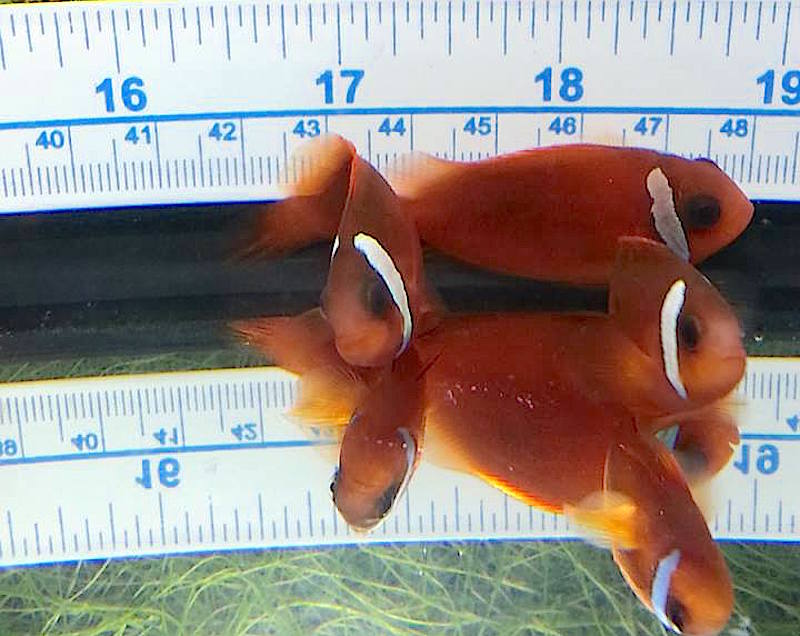Clownfish breeder Paul Tremblay of 2 Clowns in Gatineau, Quebec, Canada, has been working on a hybrid project since early February, 2015. The story goes like this according to Paul; “We had this nice wild female [Barberi Clownfish] by herself, and one of our Fire Clowns was so mean we could not pair it with anything. That is, until we decided to match him with this big female.
They settled instantly and the rest is history. The pair belongs to my partner Tino Rossanese, and I brought the pair at my place to try and have them spawn, it worked!” This primary hybrid (the initial hybridization between two distinct species) could never happen in nature; the Amphiprion barberi being from Fiji in the Pacific, and the Proaquatix-reared Amphiprion ephippium being a native of the eastern Indian Ocean.
Multiple spawns of Amphiprion (barberi ‘Fiji’ X ephippium) have been hatched and reared, from February 20th, March 6-7th, March 20th and April 16th, 2015. The resultant offspring showed only headstripes and dorsal spot, the remnants of a 2nd stripe, by 69 days of age.

Now, at an age of 8 to 10 months, we get a look at what juveniles look like; solid red fish with white cheek stripes. Almost like “Red Mccullochi Clownfish” (minus a white tail). “They all started up with a full band and gradually, the band has split on top of the head and remains only on both sides of the face, creating a very nice, bright and somewhat different clownfish that I am personally very proud of,” wrote Tremblay.
The Split Face Clownfish is a a perfect example of how crossing two closely related species gives you a predictable, consistent result right in the middle. The parental genetics are at odds; Barberi “wants” a headstripe, while the Fire Clown genetics want to remove all traces of a headstripe by the time the fish are a little over an inch long.
Clearly, something in the middle has occurred; presumably headstriping may be even further reduced as the fish age; it’s not unrealistic to think that white cheek “slashes” might be all that remain when the fish reach maturity. Since both fish are otherwise solid red on the flanks and fins as juveniles, it’s hardly surprising these hybrid offspring share these traits with their parents. Fire Clowns, upon maturity, can be very dark brown to black on the rear dorsal flank; how much of that will develop we can only guess, as Barberi can at times share a similar trait, although to a far lesser degree than the Fire Clownfish.
Of course, the Split Face Clownfish is also a perfect example of how mating two very similar and related species can produce results that are difficult for the untrained eye to even notice. Such fishes have caused major headaches for freshwater breeders for decades, particularly when hybrids are passed off as pure fish to unsuspecting hobbyists. Hybrids like these can cause huge problems in breeding programs, particularly those with an eye towards conserving natural biodiversity and unique biogeographic forms.
Paul’s own thoughts explain the issue quite succinctly. “I am actually thinking of splitting [the parents apart] as I am concerned that if I sell [the offspring] some will be resold as Tomatoes, misbarred Fire Clowns, etc.” Truthfully, were it not for their much larger size, they do simply look like juvenile Fire Clowns still in the process of losing their headstripes (something which nearly every Fire Clown does by the time it reaches market size). Tremblay’s concerns are quite true; the trade doesn’t always do a good job at properly applying names to the fish that come around (eg. anyone want to take a stab at what an “African Clownfish” being shipped out of the Philippines actually is?).
In a perfect world, Tremblay and Rossanese could sell off their new hybrid Split Face Clowns and people would a) keep the name intact with the fish and b) make sure to breed / sell the fish and their offspring accordingly. In the real world, I would have concerns over these fish being released to most hobbyists.
Of course, with already somewhat limited demand for clownfishes of the Tomato species complex, one has to question whether we need a hybrid when really cool natural variants like the Stripeless Cinnamon have a hard time getting the recognition they deserve. That said, so long as breeders have access to the parental forms of this hybrid (Barberi & Fire), then the Split Face Clownfish can always be “remade”. And, out of respect for the originators of the cross, the name Split Face should be the only name applied to this particular hybrid.
What do you think?





